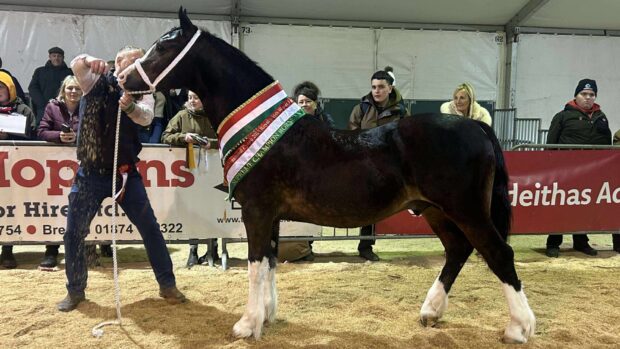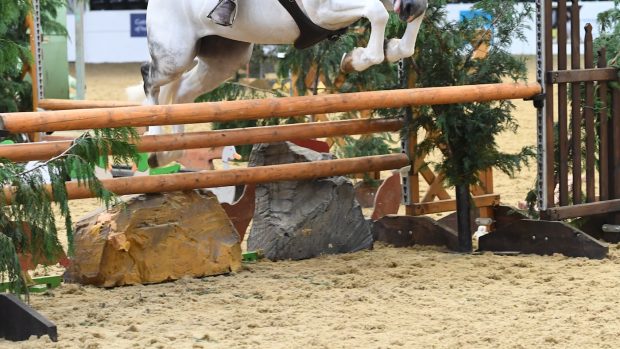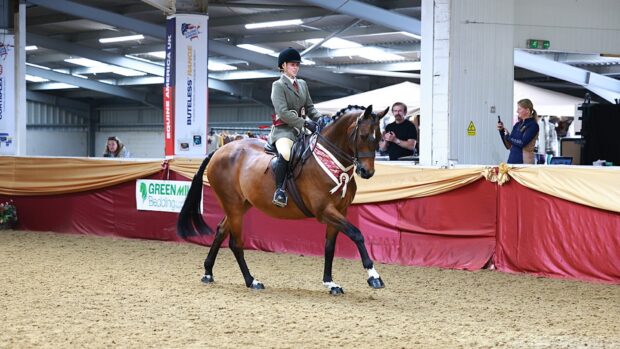Marjorie Ramsay cites the words “My child doesn’t need lessons because she shows” as the most telling remark she has heard.
Marjorie and her husband Richard, who specialise in training show horses and ponies with their riders, have been responsible for numerous HOYS and RIHS champions over the years. Having both trained with the late, legendary Edy Goldman, the couple are well qualified to pass on advice and feel that many children who have enjoyed success in the show ring are lackingin fundamental knowledge.
Both are keen to stress that children “must have proper instruction, with a thorough knowledge of the basics. Hopefully, this will encourage them to go on into other equestrian disciplines. We still feel the best preparation for balance is hunting, although not necessarily on a show pony.”
At the show
Preparation, timing and calmness are all-important on the day.Arrive in plenty of time – 2hr before your class is a good guide until you know your pony well; arriving late is an absolute disaster.
Give your pony time to settle after the journey, then unbox and ride round quietly. Give him time to take in his surroundings and settle down before you start more complex work such as figure-of-eights.
Work-in in the tack your pony will wear in the ring, so that you know it is comfortable.
Towards the end of working-in, give the pony an extended canter to make sure it will not anticipate the gallop in its show, and that it is comfortable and well prepared.
When you have worked-in – exactly how long depends on each pony – go back to the box, where the pony most be groomed and prepared, preferably not by the rider, who then has time to change into smart clothes.
Twenty minutes before the class is due to start, mount up and walk quietly to the collecting ring, where you should have a trot and canter.
Listen out for the public address in case your class has been postponed. Check how many are in the previous class so that you can gauge timing.
Make sure the rider knows the layout of the ring so that nothing comes as a surprise.
RINGCRAFT
Ringcraft can help and enhance a performance, but it is no substitute for correct riding and schooling. Concentration and awareness are the key words, while another essential ingredient is attention to detail.
Always be aware, without making eye contact, of where the judge is standing and looking. Then quietly find a position where you can be seen on your own, without appearing too pushy or getting too close to the judge.
Make full use of the ring, keeping as close as possible to the outside rails and, where feasible, ride right into the corners. Think for yourself, do not follow the one in front.
Remember, the better you ride and the better the pony is schooled, the more easily you will be able to place it where you want to in the ring.
Whenthe steward signals the final transition to walk, prior to being pulled into line, do not get left on the rails or in a bunch. Be prepared for what is going to happen, keep paying attention and keep the pony walking out into his bridle. Remember that the walk is the first and last thing the judge sees.
Watch out for other competitors – you need eyes in the back of your head.
When you are in the ring, look as though you are enjoying it.However good the pony, the competition is such that, unless your riding and presentation are top-class, you may not be looked at.
The individual show
- Simple and perfect is in, long and muddled is out.
- Arriving late
- Badly fitting clothes, untidy hair, too much decoration
- Wrongly fitted tack
- Inadequate trimming: tail too long/untidy plaits
- . Trotting too fast, out of the pony¨s natural rhythm, in a mistaken bid to show good movement
- Sitting too far back to present a good front, which drives the pony on to its forehand and puts weight on its loins
- Getting yourself covered up in a bunch of ponies
- Lack of concentration
- . Not checking shoes beforehand
- . Not reading the rules of the relevant society
Homework
Work put in before the show will pay handsome dividends. It is vital to school the pony at home, in all the paces, and to practise your individual show, although not to the point where it becomes repetitive. Make sure your pony is entered in the most suitable class and if you are not sure, seek expert advice.
Make sure your pony is used to going into the lorry or trailer; a panic on show day is not advisable. If it has not been out before, give it a trial run at a small show – if necessary, just ride around without competing.
Practise for the conformation judging at home. The judge must be able to see all four legs at a glance from either side when you stand the ponyup; also, make sure the pony walks up actively and trots back freely in a straight line towards the judge – without knocking him down!
If you are showing in affiliated classes, make sure your registration and your pony¨s vaccinations and certificates are up to date.
The video Showing to Perfection (£15.99, plus £2 p&p), featuring Richard and Marjorie Ramsay and Robert Oliver, is available from Perfection Productions, PO Box 114, Totton, Southampton SO43 7ZD.
10 Common mistakes



